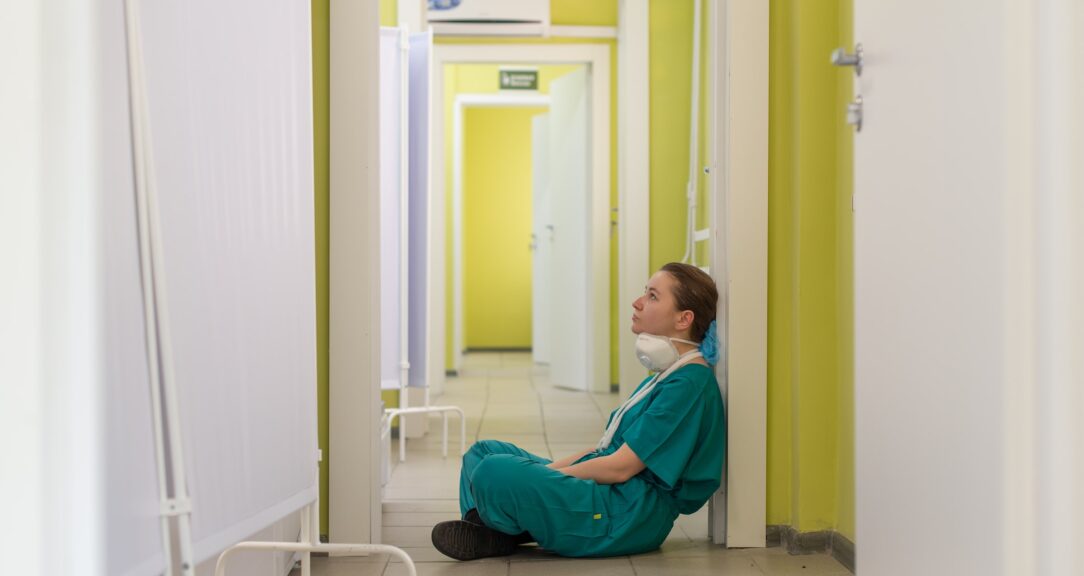When the Indian government announced a complete lockdown in March 2020, Jasleen was at her wit’s end.
Before the pandemic, the communications professional at a Delhi-based think tank mostly focused on her professional work. She was gone from 7:30 a.m. to 6:30 p.m. each day including her commuting time. Hired help minded the house while she was away so she could focus on her daughter, husband and elderly mother-in-law after work.
But after the lockdowns started, Jasleen was working from home, where the household chores were piling up and her daughter’s online schooling had to be supervised. Her mother-in-law helped where she could, but the domestic worker was gone, and her husband had his own business to run. “It was challenging,” Jasleen says. “It was also very, very exhausting.”
Whether caring for children, aging parents or friends, informal caregivers have struggled to find any semblance of work-life balance since the pandemic began.
Women were already doing three times as much unpaid care and domestic work as men before Covid-19, according to the U.N. During the pandemic, that burden only increased, and the effect was visible in the economy. In early 2020, women made up 39% of global workers, yet accounted for 54% of total job losses.
Jasleen says employers have this idea that since employees work from home, they are slacking off, or that it is easy. “It didn’t mean less work,” she says. “In fact, we had to be more proactive to prove that we were not taking it easy. It was a different kind of pressure altogether.”
Moreover, to cope with the financial challenges of the pandemic, Jasleen’s company reduced her salary by almost half for eight months. “But that did not mean a reduced amount of work,” she says.
While many people were working from home over the past two years, the global crisis for caregivers was often invisible to employers. But more companies are now paying attention to this important question: Who is taking care of the caregivers?
The mental toll of the pandemic
The size of the so-called “sandwich generation” — people taking care of children or grandchildren as well as their own parents — is growing as we live longer. The responsibility still largely falls on women.
The National Alliance for Caregiving estimates that one in six working Americans provides unpaid care to a family member or friend with a serious health condition. A report by the U.S. Centers for Disease Control and Prevention (CDC) released last year confirmed that the impact of the pandemic on parents and caregivers has been particularly devastating. The CDC found that almost one-third (32%) of caregivers reported experiencing suicidal ideation in the past month. That rose to 51.5% for people caring for both their own children and their parents.
The Australian Institute of Family Studies conducted a series of surveys on caregiving during the pandemic over the course of 2020 and 2021. Senior Researcher Jennifer Baxter has been focusing on the gendered nature of caregiving.
“What we saw early in the pandemic seemed like there was a little bit of an exciting shift, where everybody was working at home. So, there was maybe a bit of awareness of the issues for people caring for children. And the men got a little bit more involved in helping,” Baxter says. But as Covid-19 restrictions eased, “that kind of disappeared, and everything returned to the same patterns.”
Baxter’s research revealed that people experienced a lot of anxiety and stress with managing professional work and remote schooling. She acknowledges that though some employers were flexible, many people had to juggle multiple, often unpredictable, responsibilities.
“For example, the teachers trying to teach while remote schooling their children, which was an impossible task for some families,” Baxter says.
In the United Kingdom, Carers Trust conducted a survey of young carers in 2020 that highlighted a steep decline in the mental health and wellbeing of young people who provide unpaid care for family members or friends.
The Carers Trust found that 59% of carers ages 18 to 25 reported worsened mental health in the first few months of the pandemic. Nearly two-thirds of young adult carers were spending at least an additional 10 hours per week on unpaid care work; nearly 15% reported their caring duties demanded more than 90 hours per week.
More recently, Carers Trust reported that 91% of unpaid caregivers feel ignored by the U.K. government.
A study published in Frontiers in Public Health analyzing the effects of Covid-19 on caregivers and care recipients in Europe and Israel found that the frequency of people caring for parents increased, as did strains on mental health.
A significant part of care in Europe takes place in the home, and is carried out by family members or paid service providers. But many migrant care workers returned to their home countries during the pandemic and could not return afterwards.
All of the studies highlight the urgency of caregiver issues and caregiver mental health, and the need for resources and education to support them better. While governments move slowly by nature, employers can step up and act quickly to support caregivers.
Hidden carers around the world
We went to Chile, Nigeria, Turkey, Switzerland and the United States to find out how caregivers who also work full time have been doing in the pandemic.
Caregiving policies and best practices
To promote a culture of empathy and understanding in the workplace, employers need to understand that carers often have to take time off work at short notice for medical appointments or emergencies, and may not be working at full capacity all of the time.
Ask your workers what they need: Rather than making company-wide proposals for how to support caregivers, empower managers to create solutions for their own teams by talking to employees about what kind of support they need. The answers might lead to surprising solutions.
“Sometimes, validating the employee’s caregiving concerns and lending a sympathetic ear are the most crucial things an HR expert or management can do,” says Neetu Vasanta, managing director and partner, BCG India.
Revisit family leave policies: The country or region the employee is based in will dictate minimum leave for having a baby or caring for an ill relative, but consider expanding this offering beyond what’s mandated. Employees who feel respected and who can better balance life and work are more likely to stay with the company.
According to Vasanta, many people needed leave during the pandemic. She says that about one-third of her office’s staff was infected or quarantined during the worst of the outbreak, and almost everybody had a critically ill family member at some point. “We constituted a rapid response team that cared for everybody and their families, including doctor consultation and hospitalization.”
Build in staffing redundancies: The “just-in-time” scheduling methods popularized in the past decade have proven to be unsustainable in the pandemic. Keeping staffing levels at the bare minimum is a recipe for disaster.
USSalvageYards founder Emma Gordon has a hybrid workforce, with many of her in-person employees caring for children or elderly parents, so she has built contingency plans into the system. “On days when there is an unplanned absence by any worker, there’s an emergency protocol to cover up for them without slowing down procedures,” she says.
Offer flexible and part-time working hours: Caregivers often need reduced or flexible hours to balance their work with their home lives. Gordon says business owners should understand that and support carers by working with them. “Adopt a part-time employment strategy with protocols that can help the business still strive even in their absence,” she says.
Create a culture of self-care: Managers should lead by example, taking their allotted breaks and holidays. Vasanta believes that when leadership prioritizes people and puts them at the center of decisions, they will make the right choices. “If you believe that you need to protect and care for your employees, make sure you invest in them in the short term, because the returns in the long term will be significantly high,” she says.
Vasanta says her company in India has learned a lot from the pandemic. One aspect of working from home was the routine disruption. “There were meetings at 9 p.m. People were not taking enough breaks, and they had desk lunches,” she says.
To prevent the burnout of their employees, the company started sharing best practices when working from home. This included blocking off lunchtime and virtual exercise sessions. “We encouraged our employees to take Covid-19 leave so they could take some time off and be at home. This was to ensure that employees had some balance in their lives,” Vasanta says.
She adds that flexibility is great, but sometimes a longer leave is necessary. “Paid time off, which can come in the form of general PTO that workers can use for any purpose or designated caregiver leave, can ease the strain on the employee.”
The road ahead
Jasleen was due for a promotion in October 2020. But because of the company’s financial situation, this was delayed until April 2021. She lost out on the benefits that come with a promotion, including incentives and salary growth. “I am two years behind in my career growth due to the pandemic,” she says.
She says working from home should be normalized. “I think it is very important for organizations to allow their employees to work from home a few days a week,” Jasleen says. Although, she admits that working from home was initially challenging because she was not used to it. However, she has realized that it provides a better work-life balance. “If I work from home two days a week, I save four hours of travel time.” She points out that she can use these hours to attend to family and work. “I am not tired, and my concentration is better.”
Jasleen wanted to change jobs last year but could not because of the economic crisis in India. She hopes this year will be better and perhaps return to normal by next year. “I hope that by 2023 the job market will open up again,” she says. Right now, she is on a six-month maternity leave.
She says the pandemic opened her eyes. After witnessing the horror wreaked by the second wave of Covid-19 in India, Jasleen started taking her health more seriously. “Before the pandemic, I was so busy managing work and the household that I had no time for myself,” she says. “You have to take time for yourself to read a book perhaps or pamper yourself.”
Read more
Sign up to keep up to date with ReThink Q.












